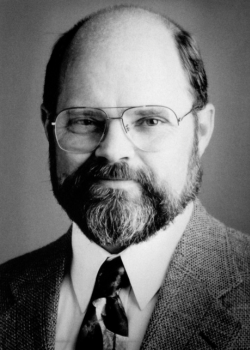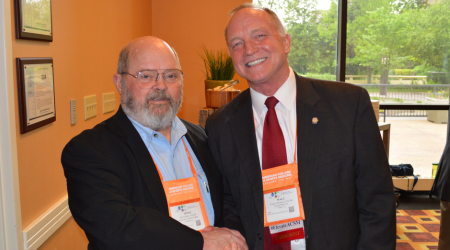The American College of Sports Medicine® is saddened to announce that Steve N. Blair, PED, FACSM, passed away on Oct. 6, 2023. He was 84 years old. The response from the sports medicine and exercise community has been profound.
Blair was a giant in the field of exercise epidemiology. An ACSM past president (1996-97), ACSM Honor Award recipient, and Joseph B. Wolffe memorial lecturer, Blair grew up on a Kansas farm before pursuing a B.A. in physical education from Kansas Wesleyan University, which he completed in 1962. His next steps were to earn an M.S. in physical education from Indiana University Bloomington in 1965 and a PED in the same, also at Bloomington, in 1968. He later completed a postdoctoral fellowship in preventive cardiology at Stanford University.
 Blair held prominent roles at a number of leading universities and organizations, chief among them the Cooper Institute (1980-2006) — serving first as director both of epidemiology and clinical applications as well as director of research, and subsequently as president and CEO — and the University of South Carolina, where he was first an instructor and then professor (1966-84), then after the two-decade gap spent at the Cooper Institute, professor (2006-16) and Distinguished Professor Emeritus (2016-23) in the Departments of Exercise Science and Epidemiology/Biostatistics.
Blair held prominent roles at a number of leading universities and organizations, chief among them the Cooper Institute (1980-2006) — serving first as director both of epidemiology and clinical applications as well as director of research, and subsequently as president and CEO — and the University of South Carolina, where he was first an instructor and then professor (1966-84), then after the two-decade gap spent at the Cooper Institute, professor (2006-16) and Distinguished Professor Emeritus (2016-23) in the Departments of Exercise Science and Epidemiology/Biostatistics.
Blair joined ACSM relatively early in his career — at a time, he recalls in an interview alongside longtime mentor and collaborator Ralph S. Paffenbarger, M.D., Dr.PH, FACSM, when one still had to be nominated in order to do so. His first annual meeting was in Atlanta in 1969. Blair is probably best known, alongside Paffenbarger and Jerry Morris, M.D., for his work in and promotion of exercise epidemiology, particularly for contributions to the world-renowned Aerobics Center Longitudinal Study. Blair’s efforts in this realm laid the groundwork for many subsequent ACSM members’ careers.
Blair founded and served as the first president of the U.S. National Coalition to Promote Physical Activity and was also senior scientific editor for the very first U.S. Surgeon General’s Report on Physical Activity. He likewise contributed to numerous statements and publications from ACSM and other leading associations regarding the importance of physical activity for overall health. Though his work was wide-ranging in scope, perhaps the central question of his career was related to the dose response of physical activity — what is enough, and to what extent is some better than none?
Blair held four honorary doctoral degrees, served as editor of or on the editorial board for numerous exercise science and sports medicine journals (including ACSM’s Exercise and Sport Sciences Reviews and Medicine and Science in Sports and Exercise®), and presented far too many named lectures (among them the Wolffe) to comfortably include in this piece. His fellowships, honors, and certifications are likewise numerous, from being listed as one of the “World’s Most Influential Minds” by Thompson Reuters in in 2014 and 2015 to being inducted into the National Fitness Hall of Fame in 2006.

Blair’s extensive CV, as published on the USC website at the time of this writing, shows that his publications have received in excess of 65,000 citations. His h index was 122. His most highly cited article has received 2,000 citations, 14 of his articles have been cited more than 1,000 times, and 22 have been cited >500 times. To say that his research has had an impact on the field would be a gross understatement. Friend and colleague James Skinner, Ph.D., FACSM, puts it this way:
“How does one describe a lifetime of research, lecturing, and service to ACSM, to the area of physical activity and health? He was involved in so many position statements from ACSM, AHA, CDC, NIH that his contributions were very widespread and important. He received many prestigious awards.”
Blair was also instrumental in the development of Exercise is Medicine® (EIM), which subsequently grew into an influential worldwide health initiative. After its founding, Blair continued to work with EIM on an ongoing basis, including serving on the EIM Program Committee for roughly a decade, only stepping down in 2021.
Blair certainly lived by the phrase “exercise is medicine,” but he also wasn’t one to mince words. In a 2005 New York Times article, he’s quoted as saying, “I’m a short, fat guy who runs every day.” Yet the regular exercise certainly showed, as ACSM Past President NiCole Keith, Ph.D., FACSM, recalls from one particular outing:
“I was a few months pregnant and tried to go on a walk with Steve. We were in Utah, and it was hilly. I had to go back to the hotel because I physically couldn’t keep up with him. He was one fast walker.”
Blair will be remembered not only as a pioneer in the field of exercise epidemiology but as a gracious friend, colleague, and mentor.
According to Skinner, “He was a caring, giving, intelligent, and hard-working person who looked for ways to help the college, the profession and the people around him. All of these groups were better off because he was in their life.”
Paffenbarger-Blair Fund for Epidemiological Research on Physical Activity | Early Career Research Grant
This grant, named for Ralph S. Paffenbarger Jr., M.D., Dr.PH, FACSM, and Steven N. Blair, P.E.D., FACSM, is to encourage researchers early in their career to become involved with physical activity epidemiology. Applications may focus on observational studies of physical activity and health outcomes, or on randomized controlled trials focused on physical activity and important public health issues.